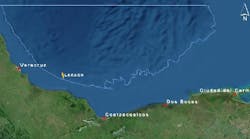Offshore staff
ABERDEEN, UK – Statoil is targeting a “pretty high level of cost cutting” for the deepwater Johan Castberg development in the Norwegian Barents Sea, said subsea project manager Benedicte Nordang at the DOT International conference.
Nordang, one of the speakers in the panel discussion on practical approaches to reducedeepwater project costs, said Statoil aims to recover 600 MMboe from Johan Castberg, mainly from the Havis and Skrugard fields. The current plan is to drill 40 wells and lay 170 km (106 mi) of infield lines on an irregular seabed.
Initially the company was pushing for start-up in 2019, but the schedule had to be delayed a year ago because concept selection was not decided. There have been further delays this summer, linked to disappointing exploration drilling (which had been designed to prove further reserves to improve the project’s economics). Now the partners are aiming for a final concept decision next summer.
In February, Statoil introduced its STEP efficiency program with a view to cut the project’s capex costs by 25%. Nordang pointed out that since 2003, the cost of subsea production systems has almost tripled while Statoil’s overall subsea project costs have doubled in recent years.
“The increase in engineering has been three to four times what we did 10 years ago,” she said. The situation has caused the company to put on hold nearly all its new development projects, she added.
STEP is focused on six high impact areas where the company sees scope to reduce costs. The two most relevant to Johan Castberg are Early Phase and Standardization/Industrialization, Nordang said. “We need to copy, buy, and re-use more of the same things over and over.
“We haven’t seen cost savings yet, but we have identified NOK 5 billion ($761 million) in potential savings to the SURF [subsea umbilicals, risers, and flowlines] part.” Some of these have a higher level of probability than others. “We are doing this in a systematic way. Using our risk and opportunity system, we report every month on whether or how we have achieved cost savings, and if not, why not.”
TheJohan Castberg team is generally striving for more flexibility in the design approach, she continued. “How much implementation do we really need, can we re-use the engineering analysis rather than keep having to start again?”
The team has also implemented TRIP, a technical improvement project, designed to simplify and take out excessive requirements. “And we are standardizing packages wherever we can, and trying to use packages that the suppliers can actually deliver.” For Johan Castberg’s subsea production system, this includes the manifolds, templates and christmas trees, she said.
Efficiency extends to safety. Although Statoil is committed to putting subsea isolation valves on all Johan Castberg’s gas injection and production pipelines, the company does see scope for removing SSIVS from the FPSO itself, in order to simplify the design and achieve potential costs savings of NOK 25 million ($3.8 million).
To reduce time and paperwork, the team has cut out what it has identified as excessive requirements in terms of complying with ISO and national standards, “or we have re-written them to be much cleverer.”
The entire exercise is due to be completed by December. “Next we aim to go further by looking at the project’s functional requirements,” she said, citing as an example adopting a new 7-in. vertical christmas tree to cut the project’s drilling costs by NOK 300 million ($46 million)/well. “We also want to be able to install the trees with a vessel, instead of a rig. That takes out a lot of rig time.
“If we can also simplify inspection and life cycle testing,” she added, “we believe we can reduce the capex of the subsea system by 25%.”
Mike Wylie, group technology director at SBM Offshore, spoke of escalating costs on the newer deepwaterFPSOs. The reason, he explained, is that as production goes into deeper and higher pressure reservoirs, more complex and heavier equipment has to be added to the topsides for duties such as crude oil desalting, scale mitigation, and removal of sulphate, CO2 and H2S.
There is scope for contractors to include more compact process equipment, he said, although this will involve improved and earlier interaction with suppliers during a project.
FPSOs generally cost more, he added, where the client insists on highly-detailed “prescriptive” specifications, a situation where the contractor is told to build the system and its components by following strict guidelines. There is more scope for savings, he added, in the case of functional specifications that give the contractor more latitude to procure the equipment from its suppliers via standard call-off frame agreements.
10/15/2014




